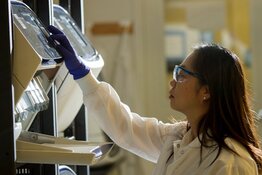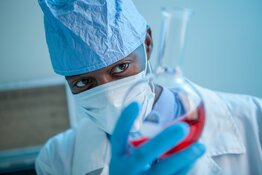The Life Sciences Report: Steve, you have something you'd like to get off your mind. Tell me.
Steve Brozak: We are seeing a dislocation in the markets. Obviously, we're seeing all-time stock market highs in the Dow Jones averages, but the same is not true for biotechnology.
TLSR: Biotech has had a good run. But you still believe it is lagging as a group—or do you see specific instances that are obvious to you?
SB: I believe some truly innovative companies are not receiving their due. Three companies that I will mention today have gotten U.S. Food and Drug Administration (FDA) approvals, and have actually either seen their stocks stay the same or decline since those approvals. I find that to be absolutely counterintuitive and demonstrative of a broken system.
TLSR: Certainly, we've had this longstanding theme in biotech where it's always the cancer drugs that get attention from investors. Isn't that right?
SB: Yes, cancer gets the attention. But a lot of investor attention has been focused on the "ultraorphan" disease indications, where an exceedingly small population is affected. Yet because no single insurance company or single payer is significantly challenged, companies are able to generate enough revenue.
I think this model is one that, frankly, is going to become more and more problematic as the budget cutbacks hit us. We are operating in a sequestration environment where the new budget is going to be an unpleasant reality.
TLSR: Go ahead with your thoughts. If you can relate those to some of the companies you want to talk about, that would be great.
SB: I saw a slide at Johnson & Johnson’s (JNJ:NYSE) last quarterly event that showed there will be trillions of dollars' worth of demand for healthcare, which is absolutely correct. The problem is, who is going to pay all those trillions of dollars? Under the current state of the medical arts, science and reimbursement, we don't have the money to pay for what we have, much less a growth in demand.
TLSR: Could you relate that to your investment thesis?
SB: One of my themes is a stem-cell reality. We are looking at an unfortunate demographic situation, with many serious disease indications that cannot be solved and can only be managed through palliative care or monitoring of patients. The sum total of these costs is prohibitive to our national healthcare system. What are the solutions to some of these problems? I can only think of the regenerative medicine space as a ubiquitous answer.
TLSR: Go ahead. Be a little more specific on that.
SB: I'll give you a couple of examples. Starting alphabetically, Aastrom Biosciences Inc. (ASTM:NASDAQ) has made a difficult but necessary financial decision. To gain approval for its patient-specific expanded stem cell technology less expensively and more quickly, the company will stop its development of ixmyelocel-T and its phase 3 REVIVE trial in critical limb ischemia. It will focus its resources on the treatment of another coronary vascular disease, dilated cardiomyopathy (DCM). Using U.S. orphan drug designation in the treatment of DCM, Aastrom recently initiated a phase 2b clinical trial in that indication. This change of direction could allow the company to more quickly gain approval to use ixmyelocel-T.
"We're seeing all-time stock market highs in the Dow Jones averages, but the same is not true for biotechnology."
Another one is Athersys Inc. (ATHX:NASDAQ), which is in a remarkable position in that it has a partnership with Pfizer Inc. (PFE:NYSE) for inflammatory bowel disease (IBD). It's now in a phase 2 trial with its MultiStem candidate (an allogeneic [using same species cells], single donor, multipotent, adult progenitor cell). Again, there are no satisfactory outcomes currently available for patients with IBD. Athersys is progressing down that road with a large partner that understands it will have to participate in developing this technology. The advantage to Athersys? It is partnered for just one indication, and if it sees the expected results it will be able to partner for other indications.
Ischemic stroke is another indication Athersys is looking at. That's a highly significant indication, because physicians have a short time period, or window of opportunity, in which they can help patients regain function. If not treated right away, disability problems are exacerbated, and stroke leads to outcomes that are, once again, dealt with in a palliative and watchful fashion, which is unaffordable in the current healthcare environment. This is a phase 2 program, and it's unpartnered.
TLSR: Steve, these cell technology companies have suffered mightily. Aastrom is down to a $31 million ($31M) market cap. Athersys has a $90M market cap. Why are these technologies unrecognized? My own feeling is that pharma hasn't embraced these kinds of companies because they don't fit its drug model. What do you think?
SB: I think you hit the nail right on the head. At first, the pharmaceutical industry was basically taken over by marketing people. Then the marketing people were hijacked by the financial people. As a result, you had a situation where products that were good were overmarketed. Now the consistent hallmark for all large pharmaceutical companies is that they pay out a dividend of 3–5%. Why is that number familiar? Because 3% happens to be what the 30-year Treasury bond is yielding right now, and the pharmas have become surrogates for Treasuries.
All the talking heads are telling investors that pharmaceutical companies are going to grow, grow, grow. So the investor says, "While I'm waiting, the pharmas pay me 3–5%." This is wrong-headed, because the pharmaceutical companies are losing their patent exclusivities. They have lived by the blockbuster product, and now they are dying by the loss of the blockbuster. Pharmaceutical companies are not good at understanding change. They want predictability, but science, if anything, is not predictable. Healthcare science is even less predictable.
TLSR: Given that big pharma is not a growth industry, the irony, as I see it, is that they are missing out. They have absolutely ignored the cell technology industry, even though it gives them an opportunity for real growth, whereas hardly anything else will. Ironic, no?
SB: The irony of all ironies is that the government is actually stepping in. The government understands that to continue this pill-a-day model is the equivalent of going back to Jurassic times. You can't do it. We have to think into the future.
That brings me to the next company. Cytori Therapeutics Inc. (CYTX:NASDAQ) has a government contract through the Biomedical Advanced Research and Development Authority (BARDA). The government has said it is interested in funding projects that can be categorized as dual use. In this case, BARDA has funded Cytori's treatment protocol for radiation burns, as well as the future purchase of product from Cytori. The company has the ability to use the same technology for conventional burns and wounds.
"We are looking at an unfortunate demographic situation, with many serious disease indications that cannot be solved and can only be managed. . .What are the solutions to some of these problems? I can only think of the regenerative medicine space as a ubiquitous answer."
In this situation, the government is spending money to develop a product that will be commercially viable, and not something that the agency will be stuck with until there's a nuclear accident—or something worse, like a nuclear attack. Because it is a platform technology, it's not just limited to one part of the body. It uses a patient's own stem cells to restore blood flow to an area that's been damaged or that's in need of assistance.
TLSR: Cytori's Celution System is the most modular patient-, physician-, and lab tech-friendly technology that I have seen in the stem cell industry. The Celution device can process and develop the patient's own cells from adipose tissue (body fat) into a dose of stem cells in one hour.
SB: That's correct. We talked earlier about irony in the stem cell industry. Here's another irony. Government contracts usually stipulate that if you can repeat in humans what you've done in animals, it will give you the contract. But this one says, if you can repeat in animals what you've done in humans, you've got a government contract.
TLSR: Are you trying to tell me that you think Cytori is going to be the first winner in the regenerative medicine field?
SB: I'm going to say that it is the first to have a commercial model that the government is betting on. That's because the company has already proved it. That's a difference.
TLSR: What's the next name you want to talk about?
SB: It's NeoStem Inc. (NBS:NYSA.A). NeoStem sent out a shareholder letter on March 19 saying that it had crossed the 50% enrollment mark on its PreSERVE-AMI phase 2 clinical trial with AMR-001 (autologous, bone marrow-derived, CD34+ enriched cells) in ST-segment elevation acute myocardial infarction (STEMI; heart attack). There are more than 90 patients in the trial now, and that is more than satisfactory. The cells are drawn from the patient's bone marrow, and then enriched for CD34+ cells, which are known for vascularizing potency. The cells have a three-day shelf life from completion of processing. They are then reinjected into the affected areas of the myocardium via the coronary artery associated with the ischemia (loss of blood flow). This takes place a week or more after a stent placement procedure. Safety looks good, and enrollment should be completed this year, with a six- to eight-month time lag for readout after the final patient is treated. You have a much better outcome for patients who are treated with CD34+ cells, which allow restoration of blood supply to the affected areas.
TLSR: Another company?
SB: The last company I'll mention in the cell area is BioTime Inc. (BTX:NYSE). This company has a set of subsidiaries, one of which is BioTime Acquisition Corp., which was spun off specifically to take on all of Geron Corp.’s (GERN:NASDAQ) human embryonic stem cell assets. This includes Geron's phase 1 acute spinal cord injury clinical trial, with its oligodendrocyte progenitor cells. There is also a phase 1/2 study of Geron's autologous cellular immunotherapy program in acute myelogenous leukemia.
BioTime has several different companies, in oncology and other fields, which can be opportunistic given the fact that all of this science, to one degree or other, is interrelated. Since the company has access to capital, we see it as having more to come. It looks to be the presumptive heir to all of Geron's technology.
TLSR: You have some non-cell therapy companies you wanted to talk about. Go ahead with that.
SB: On March 13, Navidea Biopharmaceuticals Inc. (NAVB:NYSE) got approval for Lymphoseek (technetium Tc 99m tilmanocept), an injectable product to locate metastatic lesions in lymph nodes draining primary tumors. This new diagnostic will be introduced and sold through Cardinal Health Inc. (CAH:NYSE), which is the single largest distributor of isotope diagnostics in the U.S. It already has a price. It already has applied for reimbursement, which is pretty much automatic. The stock went down with the approval announcement. There is a disconnect here. This is a superior product, and Cardinal Health is vending it for indications in breast cancer and melanoma. Navidea also just announced Lymphoseek's ability to identify, with a high degree of specificity, sentinel lymph nodes in patients with head-and-neck cancers. This is an important outcome, with the potential to expand Lymphoseek's use beyond its current indications. It is possible for Lymphoseek to be used in other solid tumors, such as prostate or colorectal cancers. The company is now poised to change oncology staging options.
TLSR: Steve, metastasis kills. Primary site solid tumors can be resected, but nine out of 10 deaths from solid tumors occur because of metastasis. If this product does what you say, then it's extraordinary.
SB: Right. And it's true. This product could allow something no one has ever seen before: the ability to stage and treat all solid tumors in the body. It can work for prostate cancer, for lung cancer or for any solid tumor. Clinicians have the ability to figure out if a cancer has progressed beyond the primary site with a gamma detector. What is that worth? We're not talking about hundreds of thousands of patients. We're talking about millions of patients in the U.S. alone.
TLSR: How is Lymphoseek superior to competitor products?
SB: For the first time, doctors have the ability to see if the cancer has metastasized into the lymphatic system with a great degree of accuracy. This is the last shot at stopping disease progression. Lymphoseek was created specifically for this purpose. As a result, the suspension molecule is much smaller than its sulfur colloid competitors. As a result, it can travel through any lymphatic system, whereas sulfur colloid is too large. There's really no competition.
"Pharma has lived by the blockbuster product, and now it is dying by the loss of the blockbuster."
Another feature is that Lymphoseek is pH neutral, whereas current suspension formulas are highly acidic and cause discomfort and pain. Also, dosing has been standardized. The reality is that Lymphoseek is simpler for nuclear pharmacies to make. And guess what? If you use a regular sulfur colloid for node localization, you're not going to get paid for it. The hospital has to absorb that cost. If you use Lymphoseek, the hospital will be reimbursed.
TLSR: How many points did Navidea have to give away to Cardinal Health?
SB: That is the great thing for Navidea. The company negotiated this contract at a very early stage, and this is a true revenue-sharing model that is more favorable to Navidea than to Cardinal Health.
TLSR: Is there a commitment to promote the product?
SB: Absolutely. Cardinal Health has already begun the distribution and dissemination of information about the product.
TLSR: Go ahead with another stock.
SB: Alexza Pharmaceuticals Inc. (ALXA:NASDAQ) has a product, Adasuve (loxapine), for extreme agitation. It is well known, and the Europeans have used it for years and years. If a patient presents in an emergency room setting, Adasuve can provide instantaneous relief in the form of mild sedation because it is a rapid-acting inhalation product. Contrast that with an injection, which takes time. Patients need to be monitored during the time it takes for an injection to take effect so they don't harm themselves or someone else. This could take more than an hour. Adasuve has received FDA approval, and it works in minutes.
TLSR: Alexza has a $71M market cap. How large do you imagine this market to be?
SB: That's another beautiful part about this stock. Basically, the company had a Canadian partner that decided to pull out of the deal. Alexza has run the calculations, and this looks like it could earn a couple of hundred million dollars in the U.S. alone. That's just in the initial launch.
TLSR: Did you have another stock you would mention?
SB: I'll mention a small company called NuPathe Inc. (PATH:NASDAQ). It has a migraine product called Zecuity (sumatriptan iontophoretic transdermal system). Migraine sufferers are basically totally incapacitated. Zecuity is a patch that allows them to get very quick absorption without the side effects of dealing with migraine. This is an acute treatment. When this product got approval the stock went up a bit, but it is nowhere near where it should be.
TLSR: You've just given me three names with recently approved products. Tell me your point.
SB: Navidea, Alexza and NuPathe all have new products that are available today, and large pharma is missing in action. They want products to replace their pill-a-day blockbuster products for cardiac, for cholesterol, for diabetes, for whatever. That does not exist anymore.
TLSR: Steve, you and I spoke about Trius Therapeutics Inc. (TSRX:NASDAQ) the last time we talked. We're coming up, I believe, on a second phase 3 pivotal trial right now, measuring the efficacy of its tedizolid phosphate antibiotic product (for the treatment of acute bacterial skin and skin structure infections including those caused by methicillin-resistant Staphylococcus aureus). The first trial was very good. Did you have any thoughts on it? The stock is up 21% over the past four weeks in anticipation. What do you think?
SB: It obviously demonstrates the need for antibacterials. Trius has demonstrated the fact that its product works. It has demonstrated the fact that it is filling a void. The company is doing what it said it would in an environment where very few do that.
I would say that Cempra Inc. (CEMP:NASDAQ) is another. Its lead product in development is solithromycin, for the treatment of respiratory tract infections, including community-acquired bacterial pneumonia (CABP) and bacterial urethritis comprising untreatable strains of gonorrhea. Solithromycin is currently completing its phase 3 clinical trial for the treatment of CABP and is also a real-time example of filling the hole that has emerged in healthcare.
TLSR: Steve, I enjoyed speaking with you very much. Thank you.
SB: It was my pleasure, always.
Stephen Brozak, president of WBB Securities, is a top-ranked analyst in biotechnology according to the StarMine ranking system. He has been in the securities industry for more than 20 years, where he has held positions in sales, management, investment banking and research analysis. He has been intimately involved in providing research on a number of companies. Brozak holds a bachelor's degree and a master's degree in business administration from Columbia University, and is a retired lieutenant colonel in the United States Marine Corps.
Want to read more Life Sciences Report interviews like this? Sign up for our free e-newsletter, and you'll learn when new articles have been published. To see a list of recent interviews with industry analysts and commentators, visit our Streetwise Interviews page.
DISCLOSURE:
1) George S. Mack conducted this interview for The Life Sciences Report and provides services to The Life Sciences Report as an employee or as an independent contractor. He or his family own shares of the following companies mentioned in this interview: None.
2) The following companies mentioned in the interview are sponsors of The Life Sciences Report: Johnson & Johnson, Athersys Corp. Streetwise Reports does not accept stock in exchange for its services or as sponsorship payment. Johnson & Johnson is not affiliated with Streetwise Reports.
3) Stephen Brozak: I or my family own shares of the following companies mentioned in this interview: Navidea Biopharmaceuticals Inc. I personally or my family am paid by the following companies mentioned in this interview: None. My company has a financial relationship with the following companies mentioned in this interview: WBB Securities has acted in a placement advisory role to Athersys Inc. in the last 12- months. I was not paid by Streetwise Reports for participating in this interview. Comments and opinions expressed are my own comments and opinions. I had the opportunity to review the interview for accuracy as of the date of the interview and am responsible for the content of the interview.
4) Interviews are edited for clarity. Streetwise Reports does not make editorial comments or change experts' statements without their consent.
5) The interview does not constitute investment advice. Each reader is encouraged to consult with his or her individual financial professional and any action a reader takes as a result of information presented here is his or her own responsibility. By opening this page, each reader accepts and agrees to Streetwise Reports' terms of use and full legal disclaimer.
6) From time to time, Streetwise Reports LLC and its directors, officers, employees or members of their families, as well as persons interviewed for articles and interviews on the site, may have a long or short position in securities mentioned and may make purchases and/or sales of those securities in the open market or otherwise.









































